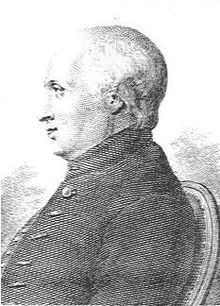Abraham Hyacinthe Anquetil-Duperron
Abraham Hyacinthe Anquetil-Duperron (born December 7, 1731 in Paris , † January 17, 1805 in Paris) was a French orientalist who is especially known for the first translation of the Avesta into a European language.
Life
Anquetil was the fourth of a total of seven children from the family of a spice merchant in Paris. He is the younger brother of the historian Louis Pierre Anquetil . Anquetil began studying theology at the Sorbonne in Paris, where he learned Hebrew and classical languages . He later continued his studies in Auxerre and Amersfoort . In 1754 he returned to Paris to take a job at the royal library. Here Antequil came across as yet undeciphered copies of the sacred writings of the Parsees , which were ascribed to Zarathustra . In order to acquire the knowledge necessary to understand them, he signed up in 1754 as a soldier for a ship destined for India . A short time later, the French government officially gave him a scientific assignment, so that he was released from the military and was able to travel to India as a scientist on a ship belonging to the French company .
In Pondicherry he learned New Persian, traveled from there to Bengal and then across India to Surat , where he made the acquaintance of the local Parse priests. He acquired manuscripts of the Zendavesta and the later Persian religious books from them , had the Destur (high priest) Darab dictate a New Persian translation of the Zendavesta into the pen, and also made himself thoroughly familiar with the customs and sacrificial customs of the Parsees.
After the capture of Pondicherry, Anquetil returned to Europe on April 28, 1761, compared his manuscripts with those there in Oxford and came to Paris on March 14, 1762 with 180 manuscripts. Through Abbé Jean Jacques Barthélemy he received the post of interpreter of the oriental languages at the royal library, to which he donated part of his treasures.
His main work, Zend-Avesta , caused a sensation throughout Europe as a first translation of the important religious book, and is still of value thanks to the supplements. On the other hand, the translation itself, which Anquetil made without knowledge of the basic language only after the above-mentioned imprecise Persian translation of his Indian teacher, is outdated by recent research.
He was the first to formulate the Axial Age theory .
A great merit Anquetil gained further by its made-to-two Persian manuscripts Latin translation of Oupnek'hat , a 1657 written Persian transfer of 50 Indian Upanishads that Dara Shikoh had made. This Latin translation appeared in two volumes in 1801 and 1802. It also found numerous readers in Germany, including a. Arthur Schopenhauer , who not only cited this work as a major influence on the formation of his own system, but also called it the most read book in world literature throughout his life.
During the French Revolution , Anquetil lived in deep seclusion. He became a member of the National Institute, but resigned out of displeasure with the situation in France. Anquetil died in dire circumstances.
Works
-
Zend-Avesta, ouvrage de Zoroastre . Paris 1771.
- German translation by Johann Friedrich Kleuker . Three volumes. Hartnoch, Riga 1776–1778.
- Ulrich Hannemann (Ed.): The Zend-Avesta. Weißensee, Berlin 2011, ISBN 978-3-89998-199-5 , (revised new edition of the Kleuker edition from 1776).
- Travels to the East Indies along with a description of the civil and religious customs of the Parsees, as an introduction to the Zend-Avesta, the code of the Parsees. Translated by JG Purmann. Garbe, Frankfurt am Main 1776.
- Oupnek'hat . Two volumes. Strasbourg 1801-1802.
literature
- Urs App : The Birth of Orientalism. University of Pennsylvania Press, Philadelphia 2010, ISBN 978-0-8122-4261-4 , (contains a 75 page chapter, pp. 363-439, on Anquetil-Duperron).
- Alexander von Bernus : Nocturnal visit. Witch fever. 2 magical occurrences. Carl, Nuremberg 1951.
- Hermann Brunnhofer : The Indian driver Anquetil Duperron. Lecture given in Aarau on February 7, 1883. Schwabe, Basel 1883.
- Raymond Schwab: Vie d'Anquetil-Duperron suivie des Usages civils et religieux des Perses par Anquetil-Duperron. Leroux, Paris 1934.
- Anquetil-Duperron . In: Brockhaus Konversations-Lexikon 1894–1896, 1st volume, pp. 667–667.
- Anquetil, 2) Abraham Hyacinthe A.-Duperron . In: Meyers Konversations-Lexikon . 4th edition. Volume 1, Verlag des Bibliographisches Institut, Leipzig / Vienna 1885–1892, pp. 611–612. - here p. 612
- Anquetil, 2) Abraham Hyacinthe A.-Duperron . In: Meyers Großes Konversations-Lexikon . 6th edition. Volume 1, Bibliographical Institute, Leipzig / Vienna 1905, p. 553 .
Individual evidence
- ↑ Jan Assmann: Axial Time. An archeology of modernity . 1st edition, Verlag CHBeck, Munich, 2018, p. 27f.
- ↑ Joas, Hans: What is Axial Time? A scientific debate as a discourse on transcendence . 1st edition. Schwabe Basel, Basel 2014, ISBN 978-3-7965-3360-0 , p. 12-13 .
- ↑ This influence is at the center of Urs App's book : Schopenhauer's Compass. The birth of a philosophy . Rorschach / Kyoto: UniversityMedia, 2011, ISBN 978-3-906000-02-2 .
| personal data | |
|---|---|
| SURNAME | Anquetil-Duperron, Abraham Hyacinthe |
| BRIEF DESCRIPTION | French orientalist |
| DATE OF BIRTH | December 7, 1731 |
| PLACE OF BIRTH | Paris |
| DATE OF DEATH | January 17, 1805 |
| Place of death | Paris |
